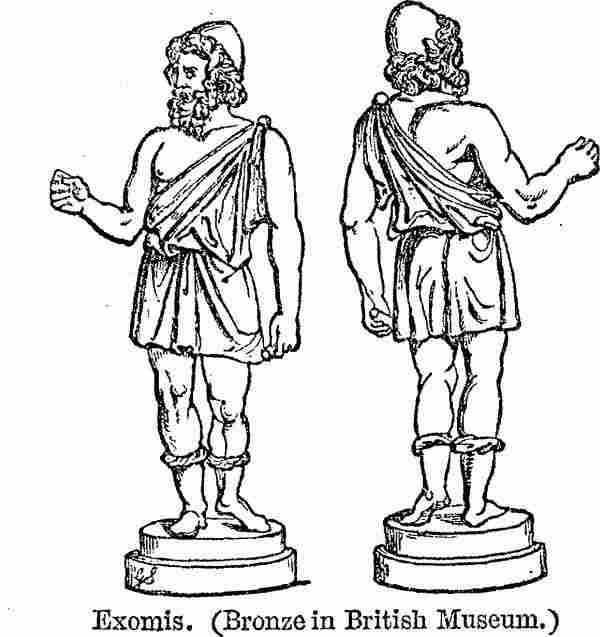.
EXO´MIS (ἐξωμίς), originally a tunic fastened over the left shoulder only (χιτὼν ἑτερομάσχαλος, Schol. Aristoph. Wasps 444; Phot. and Hesych. sub voce ἑτερομ.; Heliod. Aethiop. 3.1; Paus. 5.16.2; cf. Plaut. Mil. 4.4, 44), leaving the right shoulder and part of the breast free, and thus distinguished from the ἀμφιμάσχαλος, which was fastened over both. It was especially characteristic of workmen and slaves (Phot. s.v. Schol. Aristoph. Kn. 879, Laconizers and Cynics (Ael. VH 9.3, 4; Sext. Emp. 1.153; Suid.); while the ἀμφιμάσχαλος was used by the better classes. It was also the dress of old men in comic plays. (Pollux, 4.118), and as such worn by the chorus in the Lysisirata (662). Hephaistos as a god of labour (v. bronze in Brit. Museum, fig. p. 380, Baumeister's Denkmäler; Müller, Archäol. d. Kunst, § 366, 6) was commonly represented clothed in the exomis, as was also Odysseus. After

Exomis. (Bronze in British Museum.)
Aristophanes' time, short sleeves (χειρῖδες) were introduced in the wide holes of the χιτών, like a blouse, and the terms ἀμφιμ. and ἑτερομ. (ἐξωμίς) were equally applied to the two forms so produced (of one sleeve, Xen. Mem. 2.7, 5; v. Rich, p. 659). On the other hand, the long-sleeved tunic, χιτὼν χειριδωτός, was originally peculiar to barbarians, and accordingly appears in representations of Orpheus, the Indian Bacchus, Persians, Scythians, and the paedagogus. Later grammarians starting from the sleeved χ. wrongly interpreted ἐξωμὶς “sleeveless” (Aulus Gellius, 7.12: “citra umerum desinentes” ). The exomis, however, was not only a chiton [TUNICA], but also a ἱμάτιον or περίβλημα [PALLIUM]. According to Hesychius (s. v. Ἐξωμίς) and Aelius Dionysius (ap. Eustath. ad Il. 18.595), it served at the same time both the purposes of a chiton (διὰ τὸ ζώννυσθαι) and a himation (ὅτι τὸ ἕτερον μέρος ἐβάλλετο); but Pollux (7.48) speaks of two different kinds of exomis, one of which was a περίβλημα and the other a χιτὼν ἑτερομάσχαλος. And his account is confirmed by existing works of art. In the Museo Pio-Clementino (vol. iv., pl. 11) is a Hephaistos wearing an exomis, which is a himation thrown round the body in the way in which this garment was always worn, and which clothes the body like an exomis when it is girded round the waist. (Cf. Becker-Göll, Charikles, iii. p. 112, &c.; Guhl and Koner, ed. 5, p. 206; Hermann-Blümner, Privatalterth. p. 176; and the figure in Weiss, Kostümkunde.
Dictionary of Greek and Roman Antiquities
| Ancient Greece
Science, Technology , Medicine , Warfare, , Biographies , Life , Cities/Places/Maps , Arts , Literature , Philosophy ,Olympics, Mythology , History , Images Medieval Greece / Byzantine Empire Science, Technology, Arts, , Warfare , Literature, Biographies, Icons, History Modern Greece Cities, Islands, Regions, Fauna/Flora ,Biographies , History , Warfare, Science/Technology, Literature, Music , Arts , Film/Actors , Sport , Fashion --- |


